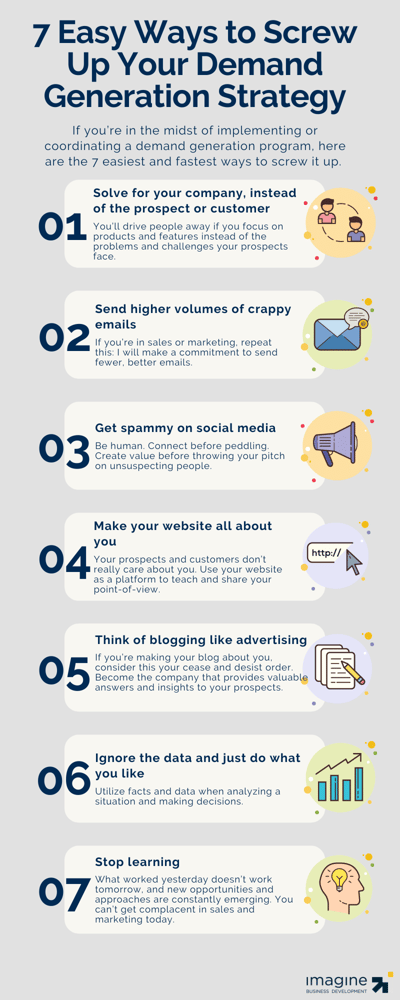 Demand generation, like so many other things, takes intense strategy, focus and discipline to succeed. It takes considerable effort and time to build the momentum that produces results, and it is incredibly easy to screw it up.
Demand generation, like so many other things, takes intense strategy, focus and discipline to succeed. It takes considerable effort and time to build the momentum that produces results, and it is incredibly easy to screw it up.
Every day more and more companies are jumping on the inbound marketing and demand generation bandwagon, and they’re investing considerable amounts to create the content and implement the processes associated with the strategy. However, the actual behaviors that they’re implementing could not be any better designed or optimized to destroy the very investments they’re making and to tarnish their reputations.
My friend and HubSpot’s VP of Sales, Pete Caputa, has begun to make it his mission to stop these behaviors, and he is imploring people to join his movement to “Stop the Sales Spam!” Despite his efforts, organizations continue to pursue tactics that create negative equity and make it more difficult for those that are doing it right.
So if you or your company is in the midst of implementing a coordinated demand generation program, and you want to know the easiest and fastest ways to screw it up, here are seven.

1. Solve for your company, instead of the prospect or customer
Prospects and customers do what they do for their reasons, not your own. I’ve advised growing organizations for years that their job is to think like their customers and to stop making customers think like you. When I say it, I get great feedback. People tell me just how much sense it makes.
Yet, they do nothing about it. Their content strategy - if they have one - still puts them at the center and they think outwards. They focus on products and features instead of the problems and challenges their prospects face. They think “how can I sell,” instead of “how can I help?”
Don’t get me wrong. Helping, without a strategy to connect to revenue is foolish. But revenue and closing sales is the byproduct of creating value, delivering a point-of-view and leading the process. The old saying is still true: people hate to be sold to, but they love to buy.
2. Send higher volumes of crappy emails
As I shared in my post yesterday, one of my biggest concerns is that the proliferation with marketing automation and the growing ecosystem around sales automation is making it easier and easier to send high volumes of emails. Because it’s so easy, people are spending less time crafting emails and creating context. As a result, the proliferation of crappy emails is exploding.
If you’re in sales or marketing, repeat after me: I will make a commitment to send fewer, better emails. If you want to know how to write better emails, read my post on the six points to crafting an effective cold email.
3. Get spammy on social media
This is my favorite (not). I regularly get requests to connect on LinkedIn. While I’ve never connected with just anybody who asks, I admit I’m pretty liberal about accepting connections. My role at Imagine, as a blogger and someone contributing to making the sales and marketing world better leads me to increase the connections I have, in an effort to allow more collaboration and communication.
Unfortunately today when I get a request, I find myself analyzing the profile with a single question, “Does this person look like someone who if I accept their request, they’re going to spam with me a commercial or fill my inmail with ‘thought you’d find this interesting’ only to include a link to their crappy we-do’s.”
If you’re one of those who are doing it - or worse, and executive that encourages or allows your people to do this - STOP!! STOP NOW. You’re not only wasting my time and yours, you’re making the world a worse place for sellers, marketers and buyers. And don’t tell me, “it works.” I don’t care if you got a lead or closed someone with the tactic. The negative equity you create - for you and others - is a multiple of whatever gain you may get.
Let’s all make a commitment to be human. To connect, before peddling. To create value, before throwing your crap on unsuspecting people who responded favorably to your request. Who knows, you may actually make a real connection and sell in the process.
4. Make your website all about you
I’ve got news for a large percentage of marketers out there. Your prospects and customer don’t really care about you. The more you make your website all about you, the more you’re commoditizing yourself. There is simply no phrase, feature or message that is going to be so powerful that when someone sees it on your website they’re going to fall over, exclaiming “How did I ever live without this!”
Make your website about your customers. Use it as a platform to teach and share your point-of-view. Make it a resource and you’ll finally see all of the results “everybody else” is talking about.
5. Think of blogging like advertising
People do not read your blog because they want to buy something. They don’t read because they want to learn more about you. So, if you’re making your blog about you, consider this your cease and desist order.
Most people who read blogs don’t even realize they’re reading a “blog.” They’re simply trying to learn about something that matters to them. Become the person or company that provides valuable answers and insights to the important questions and problems your personas have and you’ll generate the demand you need to drive growth.
6. Ignore the data and just do what you “like”
I’m sick and tired of the frequency that executives use terms like “I think,” or “I like,” to explain why they want to do something. A couple of weeks ago I was working with a client on their website design and they wanted to do something that has proven harmful to lead generation and conversion efforts. My client argued with me saying, “I don’t see how that can be. I really like websites that have this.” My response was, “Don’t take this wrong, but I don’t care what you like. You hired me to help you achieve a growth target and there’s data that conclusively shows that what you want to do doesn’t work.”
In another instance I was working with a client on an aspect of their sales process. They felt as though what we were doing was a bit too aggressive. They commented, “If you did that with me, I wouldn’t like it and it wouldn’t work.” Same response. I replied, “That’s great, let me show the results when we do this vs. when we don’t.”
I’m not saying data tells you everything, nor am I saying you should follow data blindly. But you absolutely must utilize facts and data when analyzing a situation and making decisions. If you want to destroy your demand generation program in a glorious manner, just ignore the data.
7. Stop learning
The world changes fast. What worked yesterday doesn’t work tomorrow, and new opportunities and approaches are constantly emerging. You simply cannot get complacent in sales and marketing today.
Recently I wrote a post on the common mistakes made by veteran inbound marketers who were losing traction. In all of the cases I reviewed, these companies enjoyed great success early, only to see the impact dissipate. The reason? They stopped learning and staying on top of the trends.
Generating demand is tough. It’s a lot like building a reputation. Be sure to stay away from these seven fatal flaws and you’ll dramatically increase the probability of success.

 Doug Davidoff
Doug Davidoff